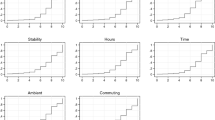Abstract
Although women constitute more than 50% of the United States’ population, their percentage among police officers is approximately 9%. Despite being relatively new to policing as fully accepted officers, their growth in numbers should be higher. Nevertheless, such growth may be stagnant. The reasons for this phenomenon are still under examination, and any research that can shed light on this quandary is useful. This article examines job satisfaction among police officers and whether there is a difference by gender. The belief is that if job satisfaction among women police officers is low, this could reflect why more women are not entering law enforcement. However, the data analyzed from a purposive sample of 2,309 male and 309 female officers suggest that there is little difference in job satisfaction solely by gender.
Similar content being viewed by others
References
Balkin, J. (1988). Why policemen don’t like policewomen.Journal of Police Science and Administration, 16(1), 29–38.
Bloch, P., & Anderson, D. (1974).Policewomen on patrol. Washington, DC: Police Foundation.
Dantzker, M. L. (1993a). Designing a measure of job satisfaction for policing.Journal of Crime and Justice, XVI(2), 171–181.
Dantzker, M. L. (1993b). An issue for policing—educational level and job satisfaction: A research note.American Journal of Police, XII(2), 101–118.
Dantzker, M. L. (1994a). Measuring job satisfaction in police departments and policy implications: An examination of a mid-sized, Southern police department.American Journal of Police, XIII(2), 77–101.
Dantzker, M. L. (1994b). Identifying determinants of job satisfaction among police officers.Journal of Police and Criminal Psychology, 10(1), 47–56.
Dantzker, M. L. (1995). Higher education and policing: Its effect on the perception of job satisfaction among police officers. In N. Ali-Jackson (Ed.),Contemporary issues in criminal justice: Shaping tomorrow’s systems (pp. 104–122). New York: McGraw-Hill.
Dantzker, M. L. (1997). Job satisfaction and community policing: A preview for future research?Police Chief, LXIV(10), 97–101.
Dantzker, M. L., & Surrette, M. A. (1996). Perceived levels of job satisfaction among police officers: A descriptive review.Journal of Police and Criminal Psychology, 11(2), 7–12.
Feldberg, R. L., & Glenn, E. N. (1979). Male and female job versus gender model in the sociology of work.Social Problems, 26(5), 524–537.
Felkenes, G. T. (1991). Affirmative action in the Los Angeles Police Department.Criminal Justice Research, 6(4), 1–9.
Fry, L., & Greensfield, S. (1980). An examination of attitudinal differences between policewomen and policemen.Journal of Applied Psychology, 65, 123–126.
Herzberg, F., Mausner, B., Peterson, R. A., & Capwell, D. F.(1957).Job attitudes review of research and opinions. Pittsburgh, PA: Psychological Services of Pittsburgh.
Hodson, R. (1989). Gender differences in job satisfaction: Why aren’t women more dissatisfied?Sociological Quarterly, 30(3), 385–399.
Horne, P. (1980).Women in law enforcement. Springfield, IL: Charles C. Thomas.
Hulin, C., & Smith, P. C. (1965). Sex differences in job satisfaction.Journal of Applied Psychology, 49, 209–216.
Jones, S. (1986).Policewomen and equality: Formal practice informal practice? London: Macmillan.
Lunneburg, P. W. (1989).Women police officers: Current career profile. Springfield, IL: Charles C. Thomas.
Mannheim, B. (1983). Men and women industrial workers: Job satisfaction, work role centrality, and work place preference.Work and Occupational Roles, 10, 413–436.
Martin, S. E. (1979).Policewomen and policewomen: Occupational role dilemmas and choices of female officers.Journal of Police Science and Administration, 7, 314–323.
Martin, S. E. (1989). Female officers on the move? A status report of women in policing. In R. Dunham & G. Alpert (Eds.),Critical issues in policing. Prospect Heights, IL: Waveland.
Martin, S. E. (1991). The effectiveness of affirmative action: The case of women in policing.Justice Quarterly, 8(4), 489–504.
Muchinsky, P. M. (1993).Psychology applied to work. (4th ed.). Pacific Grove, CA: Brooks/Cole.
Perlstein, G. R. (1972). Policewomen and policemen: A comparative look.Police Chief, 39(4), 72–74, 83.
Phelan, J. (1994). The paradox of the contented female worker: An alternative explanation.Social Psychology Quarterly, 57(2), 95–107.
Sanders, B., Hughes, T., & Langworthy, R. (1995). Police officer recruitment and selection: A survey of major police departments in the U.S.Police Forum, 5(4), 1–4.
Seagram, B. C., & Stark-Adamec, C. (1992). Women in Canadian policing: Why are they leaving?Police Chief, 59, 120–128.
Seashore, S. E., & Taber, T. D. (1975). Job satisfaction indicators and their correlates.American Behavioral Scientist, 18(3), 333–368.
Sherman, L. J. (1975). Evaluation of policewomen on patrol in a suburban police department.Journal of Police Science and Administration, 3, 434–438.
Sichel, J. L., Friedman, L. N., Quint, J. C., & Smith, M. C. (1978).Women on patrol: A pilot study of police performance in New York City. New York: Vera Institute of Justice.
Singer, M. S., & Love, K. (1988). Gender differences in self-perception of occupational efficacy: A study of law enforcement officers.Journal of Social Behavior and Personality, 3(1), 63–74.
Timmins, W. M., & Hainsworth, B. E. (1989). Attracting and retaining females in law enforcement: Sex-based problems of women cops in 1988.International Journal of Offender Therapy and Comparative Criminology, 33, 197–205.
Weaver, C. N. (1980). Job satisfaction in the United States in the 1970’s.Journal of Applied Psychology, 65, 364–367.
Weisheit, R. A. (1987). Women in the state police: Concerns of male and female officers.Journal of Police Science and Administration, 15(2), 137–144.
Worden, A. P. (1993). The attitudes of women and men in policing: Testing conventional and contemporary wisdom.Criminology, 31(2), 203–241.
Author information
Authors and Affiliations
Additional information
An erratum to this article is available at http://dx.doi.org/10.1007/BF02887279.
Rights and permissions
About this article
Cite this article
Dantzker, M.L., Kubin, B. Job satisfaction: The gender perspective among police officers. AJCJ 23, 19–31 (1998). https://doi.org/10.1007/BF02887282
Issue Date:
DOI: https://doi.org/10.1007/BF02887282




